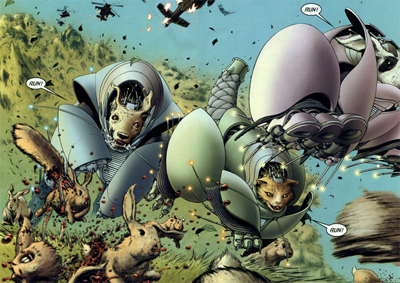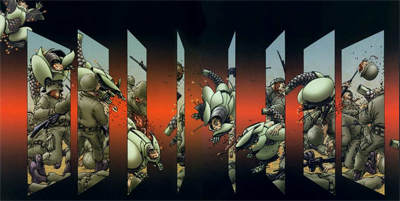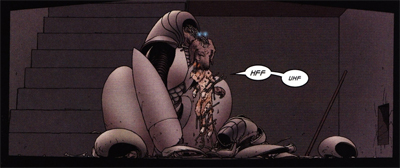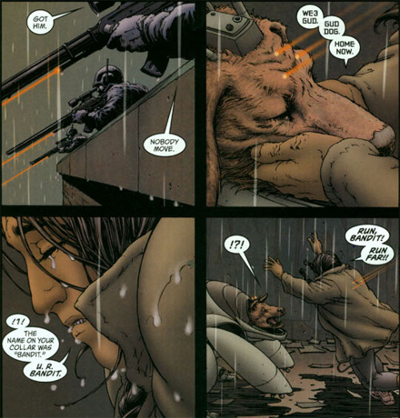December is “Grant Morrison month” here at the m0vie blog, as we take the month to consider and reflect on one of the most critically acclaimed (and polarising) authors working in the medium.
It’s Homeward Bound, but with cyborgs!
we3 has been described by Publisher’s Weekly as “Morrison’s most accessible tale ever.” I think this is mostly true. Sure, the Scottish writer can’t resist a trick or two – “we chose to treat the page not as a flat 2-D surface upon which panels were ‘pasted’ down flat but as a virtual 3-D space in which panels could be ‘hung’ and ‘rotated’ or stacked one on top of the other,” he explains in the notes at the back – but I think that we3 is the Grant Morrison book that you should be able to hand to any reader and make a fan of them. If people can’t find something emotionally or intellectually engaging in Morrison’s tale of three robot animals trying to get home, then perhaps the writer is just not for them.
I am a big fan of Morrison, but I’ll concede that the writer does have two fairly significant weaknesses. He’s a fantastic mind for high-concepts, but he tends to gloss over the basic mechanics of plotting a story – that’s the fundamental flaw with Final Crisis, which feels like somebody edited out a chapter somewhere in the middle of it all that connects the dots and provides the requisite plot details. He also sometimes has difficulty forging an emotional connection with the reader. Sometimes his ideas engage on a more intellectual level than an emotional one. In fairness to Morrison, this problem tends to come-and-go in his work, with All-Star Superman demonstrating that he’s perfectly capable of writing an emotional script.
I think we3 stands as his most emotional work. He might try to downplay that element in his commentary, where he mounts a defense of the relatively high level of on-panel violence, as if trying to offset the obvious sentimental value of a story of three animals trying to find their way home. “The visceral, forensic detail of the blood and the guts in this book has often raised eyebrows, but we felt it was a necessary ‘red in tooth and claw’ counterbalance to the sentimentality that’s always hard to avoid in tales of plucky animal pals.” While I’m not convinced that the blood and gore makes the story any less affecting, it does make it seem less manipulative, and more sincere in its attempts to generate sympathy for its three leads.
Despite Morrison’s claims to the contrary, we3 is downright heartbreaking. In particular, the way that he writes “1”, the dog leading the three-animal pack, should resonate with anybody who has ever owned a loving dog – I know that each animal has its own personality, but I think we’ve all encountered that loving and stereotypically loyal companion, that seems to thrive on the approval of its master. Morrison’s “1” captures that essence perfectly, constantly repeating with shame, “Bad dog.” I write this as somebody who has always had a family dog (or two), and who has considered them part of the family, but I think Morrison might portray the best dog I have ever seen in fiction. It’s mannerisms just seem so perfect, and Morrison manages to make it seem tragic, despite the limited vocabulary.
Morrison has always enjoyed playing with speech. There’s the disoriented text-talk clone!Batman from his Batman & Robin, or his cavemen from The Return of Bruce Wayne. Here, he attempts to portray the varying levels of intelligence between his three protagonists – an escaped trio of military experiments – through their speech patterns, with none delivering a speech that a Hollywood superstar would take any joy in reading. Instead, Morrison adopts a wonderful “less is more” approach, and it’s one that pays off.
It’s amazing how tragic Morrison can render simple statements like “is coat not we” or “boss fix tail.” Indeed, I think that the comic works remarkably well as a series of emotional devastating sequences, designed to break your heart repeatedly. Morrison’s central themes are open-ended, and you can choose to read the story as a commentary on animal experimentation or modern warfare or even just three pets trying to get home, and it works. It works because Morrison never really forces the issue. The plot is remarkably straight-forward: three cyborg animals have escaped a government research facility. The beauty lies in the individual scenes on their journey, as they try to find their way in the world.
You could argue that this is Morrison at his most basic and his most straightforward. Maybe you’d be right, but there are still more than enough clever ideas to be found in the pages. I honestly believe that Frank Quitely is Morrison’s perfect artistic partner, working with the Scottish scribe on we3, Flex Mentallo, All-Star Superman and some of his New X-Men run. The pair have a wonderful synergy going, one where it’s clear that they are in perfect harmony, like any truly great writer/artist combination. I’ve always liked Quitely’s cartoony style, but it seems perfect to render these cybernetic animals.
However, to be frank, I’m not entirely convinced that Morrison’s ambitious “3-D” sequences pay off. Apparently designed to mirror the way that animals process time, they involve overlaying several vertical panels over a long horizontal one. I admire that Morrison and Quitely tried something like this, but I don’t seem to get the desired effect when I look at it – but perhaps that’s just me. On the other hand, a superb two-page spread towards the start of the book, designed to allow “an entire sequence of events to be experienced in any order including backwards, forwards and sideways.”Again, I fear Morrison might over-sell it, but it is one incredible two-page spread, and a fine illustration of the way that author and writer play off each other.
This Deluxe Edition, one of a series of Grant-Morrison-related Deluxe Editions, comes with some great extras. There are extra pages of story, specially illustrated by Quitely, but there’s also commentary from the pair. As ever, one can sense the genuine enthusiasm that Morrison has for his work, and he seems like a guy who truly loves his work. While his work can be challenging, his commentaries are remarkably candid and frank, written with a glee that seems like honest-to-goodness love.
He’ll lavish praise on his collaborators, but he’ll also try to explain what he’s doing, rather than attempting to preserve his “mystique.”Given how much debate and discussion he frequently generates, one might forgive Morrison for disengaging and claiming that his work should stand alone, but he seems eager to explain his own reasoning and approach to it, which is really something. His work can be challenging, but it never seems like he’s trying to be intentionally oblique – he’s sharing what interests him, which I think is the aspect of his writing that encouraged me to engage with it in the first place.
we3 isn’t quite the best thing that Morrison has written, if you ask me. It is, however, perhaps the most emotionally affecting and the most wonderfully simplistic. This is Morrison at his most straight-forward, his most approachable and his most engaging. It’s also pretty great, on its own terms.
Filed under: Comics | Tagged: All Star Superman, batman, Batman and Robin, deluxe edition, final crisis, Flex Mentallo, frank quitely, grant morrison, Homeward Bound, morrison, Scotland, superman, United States, We3, we3: deluxe edition, we3: the deluxe edition |


























Leave a comment